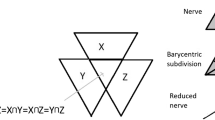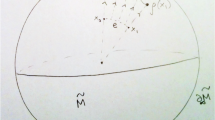Abstract
In this paper we confirm a folklore conjecture which suggests that for a complete noncompact manifold \(M\) of finite volume with sectional curvature \(-1 \leq K \leq 0\), if the universal cover of \(M\) is a visibility manifold, then the fundamental group of each end of \(M\) is almost nilpotent.

Similar content being viewed by others
References
Adams, S., Ballmann, W.: Amenable isometry groups of Hadamard spaces. Math. Ann. 312(1), 183–195 (1998)
Ballmann, W.: Spaces of nonpositive curvature. Jahresber. Dtsch. Math.-Ver. 103(2), 52–65 (2001)
Ballmann, W., Gromov, M., Schroeder, V.: Manifolds of Nonpositive Curvature. Progress in Mathematics, vol. 61. Birkhäuser, Boston (1985)
Belegradek, I.: Topology of open nonpositively curved manifolds. In: Geometry, Topology, and Dynamics in Negative Curvature. London Math. Soc. Lecture Note Ser., vol. 425, pp. 32–83. Cambridge University Press, Cambridge (2016)
Bishop, R.L., O’Neill, B.: Manifolds of negative curvature. Trans. Am. Math. Soc. 145, 1–49 (1969)
Bowditch, B.H.: Discrete parabolic groups. J. Differ. Geom. 38(3), 559–583 (1993)
Breuillard, E., Fujiwara, K.: On the joint spectral radius for isometries of non-positively curved spaces and uniform growth. Ann. Inst. Fourier (Grenoble) 71(1), 317–391 (2021)
Breuillard, E., Green, B., Tao, T.: The structure of approximate groups. Publ. Math. Inst. Hautes Études Sci. 116, 115–221 (2012)
Bridson, M.R., Haefliger, A.: Metric Spaces of Non-positive Curvature. Grundlehren der Mathematischen Wissenschaften [Fundamental Principles of Mathematical Sciences], vol. 319. Springer, Berlin (1999)
Buser, P., Karcher, H.: Gromov’s Almost Flat Manifolds. Astérisque, vol. 81. Société Mathématique de France, Paris (1981)
Caprace, P.-E.: Amenable groups and Hadamard spaces with a totally disconnected isometry group. Comment. Math. Helv. 84(2), 437–455 (2009)
Caprace, P.-E., Monod, N.: Fixed points and amenability in non-positive curvature. Math. Ann. 356(4), 1303–1337 (2013)
Cheeger, J., Colding, T.H.: Lower bounds on Ricci curvature and the almost rigidity of warped products. Ann. Math. (2) 144(1), 189–237 (1996)
Chen, L., Rong, X., Xu, S.: A geometric approach to the modified Milnor problem. Commun. Contemp. Math. 26(5), 2350018 (2024)
de la Harpe, P.: Topics in Geometric Group Theory. Chicago Lectures in Mathematics. University of Chicago Press, Chicago (2000)
Di Cerbo, L.F.: A gap property for the growth of closed 3-manifold groups. Geom. Dedic. 143, 193–199 (2009)
Eberlein, P.: Lattices in spaces of nonpositive curvature. Ann. Math. (2) 111(3), 435–476 (1980)
Eberlein, P.B.: Geometry of Nonpositively Curved Manifolds. Chicago Lectures in Mathematics. University of Chicago Press, Chicago (1996)
Eberlein, P., O’Neill, B.: Visibility manifolds. Pac. J. Math. 46, 45–109 (1973)
Eberlein, P., Hamenstädt, U., Schroeder, V.: Manifolds of nonpositive curvature. In: Differential Geometry: Riemannian Geometry (Los Angeles, CA, 1990). Proc. Sympos. Pure Math., vol. 54, pp. 179–227. Am. Math. Soc., Providence (1993)
Grigorchuk, R.I.: Degrees of growth of \(p\)-groups and torsion-free groups. Mat. Sb. (N.S.) 126(168), 194–214, 2 (1985)
Gromov, M.: Manifolds of negative curvature. J. Differ. Geom. 13(2), 223–230 (1978)
Gromov, M.: Groups of polynomial growth and expanding maps. Publ. Math. Inst. Hautes Études Sci. 53, 53–73 (1981)
Gromov, M.: Metric Structures for Riemannian and Non-Riemannian Spaces, Modern Birkhäuser Classics, Birkhäuser Boston, Inc., Boston (2007). English ed. Based on the 1981 French original, with appendices by Katz, M., Pansu, P. and Semmes, S., Translated from the French by Sean Michael Bates
Heintze, E.: Mannigfaltigkeiten negativer krümmung, Habilitation-schrift (1976)
Heintze, E., Im Hof, H.-C.: Geometry of horospheres. J. Differ. Geom. 12(4), 481–491 (1977)
Kapovitch, V., Wilking, B.: Structure of fundamental groups of manifolds with Ricci curvature bounded below. ArXiv e-prints (2011)
Karlsson, A., Margulis, G.A.: A multiplicative ergodic theorem and nonpositively curved spaces. Commun. Math. Phys. 208(1), 107–123 (1999)
Leeb, B.: A Characterization of Irreducible Symmetric Spaces and Euclidean Buildings of Higher Rank by Their Asymptotic Geometry. Bonner Mathematische Schriften [Bonn Mathematical Publications], vol. 326. Universität Bonn, Mathematisches Institut, Bonn (2000)
Raghunathan, M.S.: Discrete Subgroups of Lie groups. Ergebnisse der Mathematik und ihrer Grenzgebiete, vol. 68. Springer, New York (1972)
Schroeder, V.: Finite volume and fundamental group on manifolds of negative curvature. J. Differ. Geom. 20(1), 175–183 (1984)
Uwe, A., Schroeder, V.: Graph manifolds, ends of negatively curved spaces and the hyperbolic 120-cell space. J. Differ. Geom. 35(2), 299–336 (1992)
Wu, Y.: Translation lengths of parabolic isometries of \(\mathrm{CAT}(0)\) spaces and their applications. J. Geom. Anal. 28(1), 375–392 (2018)
Acknowledgements
The authors would like to thank Prof. P. Eberlein and Prof. S. T. Yau for their interests. They are also grateful to anonymous referees for their careful reading and valuable comments, one of which especially improves the statement of Proposition 1.4.
Funding
The second named author is partially supported by a grant from Tsinghua university and the NSFC grants No. 12171263 and 12361141813.
Author information
Authors and Affiliations
Corresponding author
Additional information
Publisher’s Note
Springer Nature remains neutral with regard to jurisdictional claims in published maps and institutional affiliations.
Appendix: A visibility manifold with a finite volume quotient is not necessarily Gromov hyperbolic
Appendix: A visibility manifold with a finite volume quotient is not necessarily Gromov hyperbolic
In this appendix we construct a complete surface of finite volume with curvature \(-1 \leq K <0\), whose universal cover is a visibility manifold but not a Gromov hyperbolic space. This example shows that the argument in the proof of Corollary 3.5 is not adapted to general visibility manifolds.
Let \((S,g)\) be a noncompact surface of constant negative curvature −1 with finite volume. Such a surface has only finitely many cusps. For simplicity we further assume that \(S\) has only one cusp \(E\), which can be expressed as \(\mathbb{S}^{1} \times [0,\infty )\) endowed with the hyperbolic metric \(\exp (-2t) \mathrm{d}\tilde{s}^{2}+\mathrm{d}t^{2}\), where \(\mathrm{d}\tilde{s}^{2}\) is the flat metric on \(\mathbb{S}^{1}\).
Let \(h:[0,\infty ) \to \mathbb{R}\) be a smooth function such that
-
(1)
\(h\) is positive and monotonically decreasing,
-
(2)
\(h''/h\) is positive and monotonically decreasing,
-
(3)
\(h=\exp (-t) \) for \(0 \leq t \leq 1\),
-
(4)
\(h=\dfrac{1}{t^{2}}\) for \(t \geq 3\).
Such a function could be constructed by elementary calculus.
We change the metric on \(E=\mathbb{S}^{1} \times [0,\infty )\) to \(h^{2}(t) \mathrm{d}\tilde{s}^{2} + \mathrm{d}t^{2}\) and obtain a new smooth metric \(g'\) on \(S\). Since both \(\mathbb{S}^{1}\) and \([0,\infty )\) are complete, their warped product is also complete (e.g., see [5, Lemma 7.2]). We first show that \((S,g')\) is a finite volume surface with bounded nonpositive curvature whose universal cover is a visibility manifold.
Let \(S'=S - (\mathbb{S}^{1} \times (3,\infty ))\). \(S'\) is a compact surface with boundary. The volume of \(S\) with respect with the new metric \(g'\) is
To see that \((S,g')\) is visible, we check that it satisfies a visibility criterion due to Eberlein and O’Neill [19, Proposition 5.9], which states that if a nonpositively curved manifold \(M\) has curvature order \(\leq 2\) at a point \(p \in M\), i.e., if
where \(\gamma _{\omega}\) is the geodesic ray with initial velocity \(\omega \) and \(k(\gamma _{\omega}(t))=\min \{|K(\pi )|: \pi \subset \mathrm{T}_{ \gamma _{\omega}(t)} \text{ is a two-dimensional subspace}\}\). Then \(M\) is a visibility manifold.
In fact, direct computation gives
where \(K_{g'}(q)\) is the Gaussian curvature at \(q\) with respect with the metric \(g'\). By the choice of \(h\), \(-1 \leq K_{g'}<0\). We have for any \(p \in \mathbb{S}^{1} \times \{0\}\) and for any \(\omega \in \mathrm{S}_{p} S\),
hence by the visibility criterion the universal cover of \((S,g')\) is a visibility surface.
It remains to show that \((S,g')\) is not Gromov hyperbolic. Let \(\tilde{S}\) be the universal cover of \((S,g')\). Assume now that \(\tilde{S}\) is \(\delta \)-hyperbolic for some \(\delta >0\). Let \(\gamma \) be a geodesic ray in \(S\) converging to the end \(E\) and \(\tilde{\gamma}\) be a lift of \(\gamma \) to \(\tilde{S}\). It is not hard to see that a horoball in \(\tilde{S}\) centered at \(\tilde{\gamma}(\infty )\) is given by \(\mathbb{R} \times [0,\infty )\) endowed with the metric \(h^{2}(t)\mathrm{d}s^{2}+\mathrm{d}t^{2}\). Denote by \(H_{-t}\) the horosphere \(\mathbb{R} \times \{t\}\) and by \(d_{H}\) the horospherical distance between two points on the same horosphere.
Let \(T>3+12 \delta \) be a sufficiently large constant. Set \(x_{0}=(0,T)\) and \(y_{0}=(2 \delta T^{2},T)\). We have
Where \(d_{H}(\cdot , \cdot )\) is the induced distance on the horosphere \(H\).
Let \(x=(0,T-2\delta )\) and \(y=(2 \delta T^{2},T-2\delta )\). The projection of the geodesic segment \(\gamma _{x,y}\) onto the horosphere \(H_{-T}\) is exactly the horospherical geodesic segment from \(x_{0}\) to \(y_{0}\). Together with a standard infinitesimal argument, this yields that
On the other hand,
Set \(w=(0,T-8\delta )\) and \(z=(2 \delta T^{2},T-8\delta )\), we have
and
Together with (40) we obtain
which tends to 0 as \(T \to \infty \). This contradicts Lemma 3.4. Therefore \(\tilde{S}\) cannot be Gromov hyperbolic. See Fig. 2.
Hence we have constructed a complete visibility surface \(S\) with bounded nonpositive curvature and finite volume whose universal cover is not Gromov hyperbolic. Examples in higher dimensions can be obtained similarly using warped products.
Rights and permissions
Springer Nature or its licensor (e.g. a society or other partner) holds exclusive rights to this article under a publishing agreement with the author(s) or other rightsholder(s); author self-archiving of the accepted manuscript version of this article is solely governed by the terms of such publishing agreement and applicable law.
About this article
Cite this article
Ji, R., Wu, Y. On ends of finite-volume noncompact manifolds of nonpositive curvature. Invent. math. (2024). https://doi.org/10.1007/s00222-024-01266-0
Received:
Accepted:
Published:
DOI: https://doi.org/10.1007/s00222-024-01266-0





